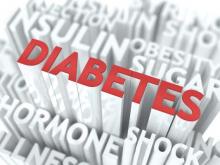BOSTON – A wearable, closed-loop bionic pancreas system that automatically delivers glucagon has been found to improve hypoglycemia control in patients with type 1 diabetes.
A double-blind, randomized, placebo-controlled, cross-over study (NCT02181127) has demonstrated the value of automated injection of glucagon in establishing glycemic regulation in adult patients with type 1 diabetes. “Automated glucagon delivery reduces hypoglycemia and increases time in range without an increase in mean glucose, with no difference in insulin dose,” said Dr. Laya Ekhlaspour of Massachusetts General Hospital, Boston.
Glycemic regulation can be problematic in young adults with type 1 diabetes, whose blood glucose levels can fall below 70 mg/dL for over 2 hours daily, even with glycemic control using conventional insulin pump therapy. The typical response to hypoglycemia – supplying glucose in a quickly digested form – is a short-term solution and is not effective during sleep.
Dr. Ekhlaspour and her colleagues surmised that a closed-loop system comprising a wearable bionic pancreas system that automatically delivers glucagon could reduce the incidence and severity of hypoglycemia when used along with the conventional insulin therapies of multiple daily injection (MDI) or continuous subcutaneous insulin infusion (CSII).
Of 31 subjects screened, 27 were eligible in terms of the frequency of hypoglycemia, but 5 were excluded because of scheduling problems, leaving 22 patients. The participants, adults with type 1 diabetes, had blood glucose levels below 60 mg/dL on average at least twice a week, and some periods with blood glucose below 50 mg/dL.
In addition to self-administered insulin (CSII or MDI), the subjects also received glucagon or placebo for 24 hours at a time using the automated wearable bionic pancreas system. In the 2-week study, the subjects (mean age 42 years; mean duration of diabetes 25 years) were randomized to receive glucagon or placebo for a total of 7 days each. The subjects were not told which preparation they were receiving.
The primary outcome of area over the curve (AOC) under 60 mg/dL was reduced by 75% on days when glucagon was supplied (851 mg/dL/min), compared with days when placebo was supplied (3,414 mg/dL/min), a significant difference. The difference in AOC was even more pronounced at night (117 vs. 1,309 mg/dL/min).
The percentage of subjects with blood glucose of 70 -180 mg/dL was significantly greater on days when glucagon was administered than when placebo was given (69% versus 62%). Subjects spent 74% less time with blood glucose under 60 mg/dL on days when glucagon was supplied, compared with placebo (1.2% versus 4.7%).
Symptomatic hypoglycemia episodes were significantly fewer for glucagon, compared with placebo (0.6 versus 1.2). The need for oral carbohydrates was reduced when glucagon was provided (1.3 versus 1.9 interventions per day). Nausea severity rankings for glucagon and placebo on the visual analog scale were similar.
Dr. Ekhlaspour had no disclosures.


